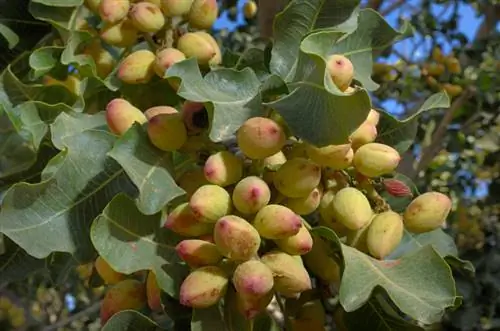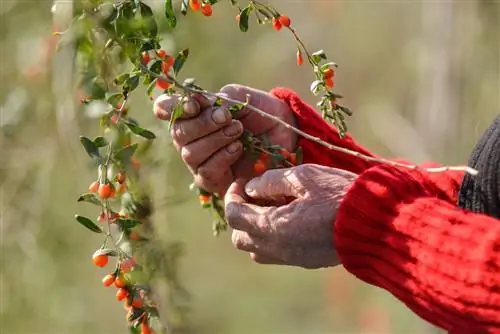- Author admin [email protected].
- Public 2023-12-16 16:46.
- Last modified 2025-01-23 11:21.
The goji berry still has a certain exotic factor in this country due to its Far Eastern origin, although its cultivation is now also established in Germany. The “Common Bocksdorn” can generally cope with harsh winters if certain conditions are met.

Are goji berries hardy and how do you protect them in winter?
Goji berries are hardy and can survive temperatures down to -25 °C. However, young plants in the ground should be covered with mulch and leaves or pine brush piled up. Potted plants require additional protection by wrapping the root area with bubble wrap (€14.00 on Amazon).
Overwinter mature shrubs in the outdoor bed
Adult goji berry bushes can generally overwinter outdoors without any problems, even in locations with harsh continental winters, as they can also survive frosty temperatures down to around -25 degrees Celsius without damage. However, it is important that the plants are in a sunny, warm summer location without waterlogging of the soil. Otherwise, it could well happen that specimens in permanently moist locations die due to root rot, mildew and other diseases.
Protect young plants easily from severe frost
Young plants bought fresh from the greenhouse or grown yourself are not yet frost-hardy enough to survive the Central European winter outdoors, especially after autumn planting. To prevent plant loss due to winter cold, you should:
- Plant young plants in the ground in spring if possible
- cover the root area of the plants with an additional layer of mulch
- pile up leaves or pile up pine branches around the winter-bare branches
Protecting the roots of potted plants from the cold
The roots of potted plants on a terrace are generally much more exposed to the winter cold than the roots of plants in outdoor beds, which are protected by the soil. That's why you should protect goji berries grown in pots in the root area from particularly cold night frosts by wrapping the pot with bubble wrap (€14.00 on Amazon). It can also protect against particularly severe frosts if potted plants are not placed directly on the stone floor of a terrace, but are placed on a thick Styrofoam plate. Since goji berries grown in pots can be more easily dried out by the wind, they should be watered occasionally on frost-free days.
Tip
Goji berries generally prefer a very sunny and warm location. However, they should not be positioned directly next to a wall during the winter months, where there are striking differences between day and night temperatures.






